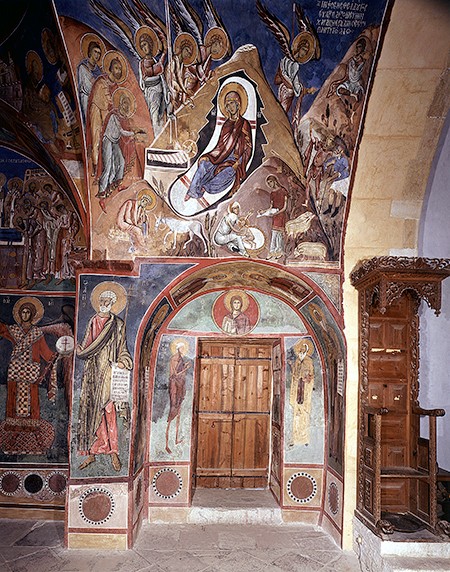Byzantine churches were often described in terms of an earthly heaven. The combined effects of glittering surfaces and monumental representations of Christ, angels, and saints in a domed architectural frame gave the impression that the divine dwelt within such interiors. Arguably, such sacred presence would have been particularly palpable for worshipers during the Middle Byzantine period (c. 843–1204), when, in contrast to earlier centuries when figural representation tended to be concentrated in the eastern part of larger basilicas, churches were comparatively small and sacred figures proliferated throughout the interior. Figures and scenes on curved surfaces such as domes and vaults enveloped beholders, fostering an intimate relationship between image and viewer famously described in 1948 by Otto Demus in his discussion of the “icon in space.”
Although the impact on viewers entering such spaces has been studied thoroughly, its counterpart has received less attention. Counterfacades and narthexes burgeon with imagery around exit doors that frame the process of going out (exodos). Both visual and literary evidence suggest that imagery near these doors participated in the multisensory experience of ritual and elicited devotional responses from the faithful as they left sacred space. However, such visual material is difficult to categorize because it embodies a range of iconography, architectural form and function, and ritual contexts. Thus, my dissertation focuses on formal and spatial relationships among images, doorways, and viewers that unfolded in the context of exodos, an approach that joins the visual, spatial, and kinetic experiences of crossing the threshold. Through this lens, I investigate how images may have engaged viewers as they left the church by pointing to eschatological, hagiographic, and theophanic themes that blur boundaries between sacred space and daily life.
In the first chapter I suggest that this view had already found expression during the Early Byzantine period, when recessionals and stational liturgies regularly crossed exit thresholds and extended ritual into urban life. Liturgy had become more interiorized by the end of Iconoclasm in 843, yet dismissal prayers continued to connect liturgy to the quotidian concerns of the faithful, and I propose that imagery at the exit was critical to maintaining this conceptual link. Subsequent chapters explore connections between visual representation and the process of exodos into other realms, broadly defined: the afterlife, the social sphere, and the natural world. Scenes such as the Dormition of the Mother of God and the Last Judgment depicted above exits from the naos and/or narthex draw out the eschatological sense of exodos as a metaphor for death and frame departure in terms of desire for bodily incorruptibility and assimilation into the community of saints. This passage was also evoked by funeral and commemorative rites; the Divine Liturgy offered the faithful a foretaste through the consumption of Christ’s body in communion.
Concerns about bodily integrity were also central to ideas about social cohesion, which was understood in terms of the relationship between a body and its parts. Viewed in the course of egress, scenes such as the Crucifixion, the Washing of the Feet, and the Pentecost display different aspects of forming community, while Judas offers an antitype in depictions of the Last Supper and the Betrayal of Christ. When placed near the door, hagiographical subjects like the Forty Martyrs of Sebaste, who freeze to death on a lake, and Constantine and Helena with the True Cross suggest that salvation history unfolds not only within the ritual context of the church but also extends to the familiar landscapes into which viewers depart and the communities that inhabit them, bringing them into a sacred topography maintained by the pious donations and virtuous behavior of a church’s patrons and congregation.
By virtue of its spatial context, exit imagery demands a dynamic relationship among images, viewers, and their spatial environments; doors admit not only the passage of people but also the atmospheric effects of sunlight. Above an exit, scenes such as the Transfiguration or the Pentecost incorporate natural light into their compositions in ways that evoke the experience of theophany depicted. Finally, I conclude by focusing on the Communion of Mary of Egypt, examples of which often appear near a door, in order to consider connections among exodos, exile, and the exposed body in extra-ecclesiastical landscapes. When placed at the exit of a church, the communion scene, which takes place on the banks of the Jordan River, complicates ideas about the limits of liturgical space by transporting the rite out of the sanctuary and to the edge of the wilderness, opening up the possibility that, even as the faithful leave the earthly heaven, the body is a site for spiritual transformation and divine revelation in the world.
